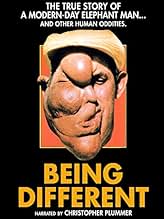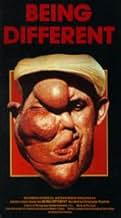This compassionate documentary offers snapshots of a number of people living productive lives while coping with physical abnormalities.This compassionate documentary offers snapshots of a number of people living productive lives while coping with physical abnormalities.This compassionate documentary offers snapshots of a number of people living productive lives while coping with physical abnormalities.
- Awards
- 2 nominations total
- Director
- Writer
- All cast & crew
- Production, box office & more at IMDbPro
Storyline
Did you know
- ConnectionsReferences The Elephant Man (1980)
Featured review
A real oddity from the early days of video rental, this ineffectual documentary on real-life 'freaks' was marketed on the back of the critical and commercial success of David Lynch's Oscar nominated 'The Elephant Man' (1980). Though the video cover announces this film as 'A true story of a modern-day Elephant Man, and other human oddities', the actual character concerned shares equal screen time with 'the other human oddities'.
Allusions to Lynch's film begin during the title sequence: a shot of a pair of legs ascending a dark staircase to a soundtrack of heavy breathing. We then cut to our Elephant Man hideously deformed face as he enters his apartment and embraces his wife. Following this we see another character jogging in the distance towards the camera. This lengthy sequence culminates as he crests the horizon and we are astonished to notice that he has no feet. There then follows a montage of assorted fairground scenes, such as 'normal people' peering into distorting mirrors, before the narrator, the Canadian classical actor Christopher Plummer, steps onto the screen to deliver the film's brief, spouting such trite lines as 'If we were they, what would our world look like?' with the required solemnity.
After a little research I discovered that Harry Rasky is actually a rather well-respected television journalist and documentary-maker in his native Canada, better known for his art documentaries on Chagall and Degas, and notably a feature on Christopher Plummer himself ('Christopher Plummer: King of Players' 1998). He also wrote the biography 'Tennessee Williams: A Portrait in Laughter and Lamentation' in 1986. 'Being Different' looks rather out of place in an otherwise distinguished oeuvre due to it's intrinsically uninformative nature, and to the fact that its emotive subject renders it a rather difficult film to view objectively.
For the initial half hour we our transported to Gibsinton, Florida, the Carnival capital of America we are informed, where we are introduced to the inhabitants of the mobile community that make their living as sideshow freaks. These included a set of Siamese Twins,'the fattest man in the world', 'the tallest man in the world' (trivia fans: this is Johann Petursson, an Icelandic giant who appeared in the 1950 film 'Prehistoric Woman') and Alligator man and the bearded Monkey Girl ('the strangest married couple in the world'). From here on we get whisked off on a guided tour of the human oddities of North America, visiting en route the world's tallest woman in Niagara Falls, a midget in Montreal, numerous limb-less people, and a convention of The Little People of America.
By allowing them to tell their stories by means of a series of interviews, Rasky admirably introduces these characters as essentially human beings who have miraculously overcome their physical disabilities to lead a normal life. There is some truly astonishing material here, including scenes of a man with no legs going swimming and a woman with no arms squeezing herself into a pair of jeans. Unfortunately we are treated to the pretty much the same old thing over and over again. There are too many similar characters shown going about their daily business, giving the same one-line responses to the prurient questioning into their sex lives, and the film is at least 20 minutes too long. A lengthy scene in a disco of 'normal people' is rather arbitrarily included to give us pause for thought about two thirds of the way through. There are also a number of appalling musical interludes which date the film badly to the 'Fame' era, consisting of montages of left-over footage accompanied by cheesy early 80's power-ballads with music by music by Paul Zaza and atrocious lyrics written by Rasky himself.
Ultimately a documentary filmmaker works with the same market concerns as those of the feature film. Despite never being truly exploitative, 'Being Different' is nevertheless grounded in the same Circus geekshow mentality of the Gibsinton carnival with which the film opens, given the respectable veneer of early 80's political correctness by a platitudinous commentary which mentions 'the triumph of the human spirit' on at least three occasions. In using real-life circus freaks within the framework of a fantasy narrative, Todd Browning's 'Freaks' (1932) was less condescending and much more interesting. Other uses of real-life freaks in cinema include Michael Winner's diabolical (in both senses of the word) horror film, 'The Sentinel' (1977).
Allusions to Lynch's film begin during the title sequence: a shot of a pair of legs ascending a dark staircase to a soundtrack of heavy breathing. We then cut to our Elephant Man hideously deformed face as he enters his apartment and embraces his wife. Following this we see another character jogging in the distance towards the camera. This lengthy sequence culminates as he crests the horizon and we are astonished to notice that he has no feet. There then follows a montage of assorted fairground scenes, such as 'normal people' peering into distorting mirrors, before the narrator, the Canadian classical actor Christopher Plummer, steps onto the screen to deliver the film's brief, spouting such trite lines as 'If we were they, what would our world look like?' with the required solemnity.
After a little research I discovered that Harry Rasky is actually a rather well-respected television journalist and documentary-maker in his native Canada, better known for his art documentaries on Chagall and Degas, and notably a feature on Christopher Plummer himself ('Christopher Plummer: King of Players' 1998). He also wrote the biography 'Tennessee Williams: A Portrait in Laughter and Lamentation' in 1986. 'Being Different' looks rather out of place in an otherwise distinguished oeuvre due to it's intrinsically uninformative nature, and to the fact that its emotive subject renders it a rather difficult film to view objectively.
For the initial half hour we our transported to Gibsinton, Florida, the Carnival capital of America we are informed, where we are introduced to the inhabitants of the mobile community that make their living as sideshow freaks. These included a set of Siamese Twins,'the fattest man in the world', 'the tallest man in the world' (trivia fans: this is Johann Petursson, an Icelandic giant who appeared in the 1950 film 'Prehistoric Woman') and Alligator man and the bearded Monkey Girl ('the strangest married couple in the world'). From here on we get whisked off on a guided tour of the human oddities of North America, visiting en route the world's tallest woman in Niagara Falls, a midget in Montreal, numerous limb-less people, and a convention of The Little People of America.
By allowing them to tell their stories by means of a series of interviews, Rasky admirably introduces these characters as essentially human beings who have miraculously overcome their physical disabilities to lead a normal life. There is some truly astonishing material here, including scenes of a man with no legs going swimming and a woman with no arms squeezing herself into a pair of jeans. Unfortunately we are treated to the pretty much the same old thing over and over again. There are too many similar characters shown going about their daily business, giving the same one-line responses to the prurient questioning into their sex lives, and the film is at least 20 minutes too long. A lengthy scene in a disco of 'normal people' is rather arbitrarily included to give us pause for thought about two thirds of the way through. There are also a number of appalling musical interludes which date the film badly to the 'Fame' era, consisting of montages of left-over footage accompanied by cheesy early 80's power-ballads with music by music by Paul Zaza and atrocious lyrics written by Rasky himself.
Ultimately a documentary filmmaker works with the same market concerns as those of the feature film. Despite never being truly exploitative, 'Being Different' is nevertheless grounded in the same Circus geekshow mentality of the Gibsinton carnival with which the film opens, given the respectable veneer of early 80's political correctness by a platitudinous commentary which mentions 'the triumph of the human spirit' on at least three occasions. In using real-life circus freaks within the framework of a fantasy narrative, Todd Browning's 'Freaks' (1932) was less condescending and much more interesting. Other uses of real-life freaks in cinema include Michael Winner's diabolical (in both senses of the word) horror film, 'The Sentinel' (1977).
Details
- Release date
- Countries of origin
- Language
- Also known as
- Annorlunda människor
- Filming locations
- Murphy Sculpture Garden - 10899 Wilshire Boulevard, UCLA, Westwood, Los Angeles, California, USA(Christopher Plummer's opening and closing scene.)
- Production companies
- See more company credits at IMDbPro
Box office
- Budget
- CA$1,500,000 (estimated)
- Runtime1 hour 43 minutes
- Color
Contribute to this page
Suggest an edit or add missing content















